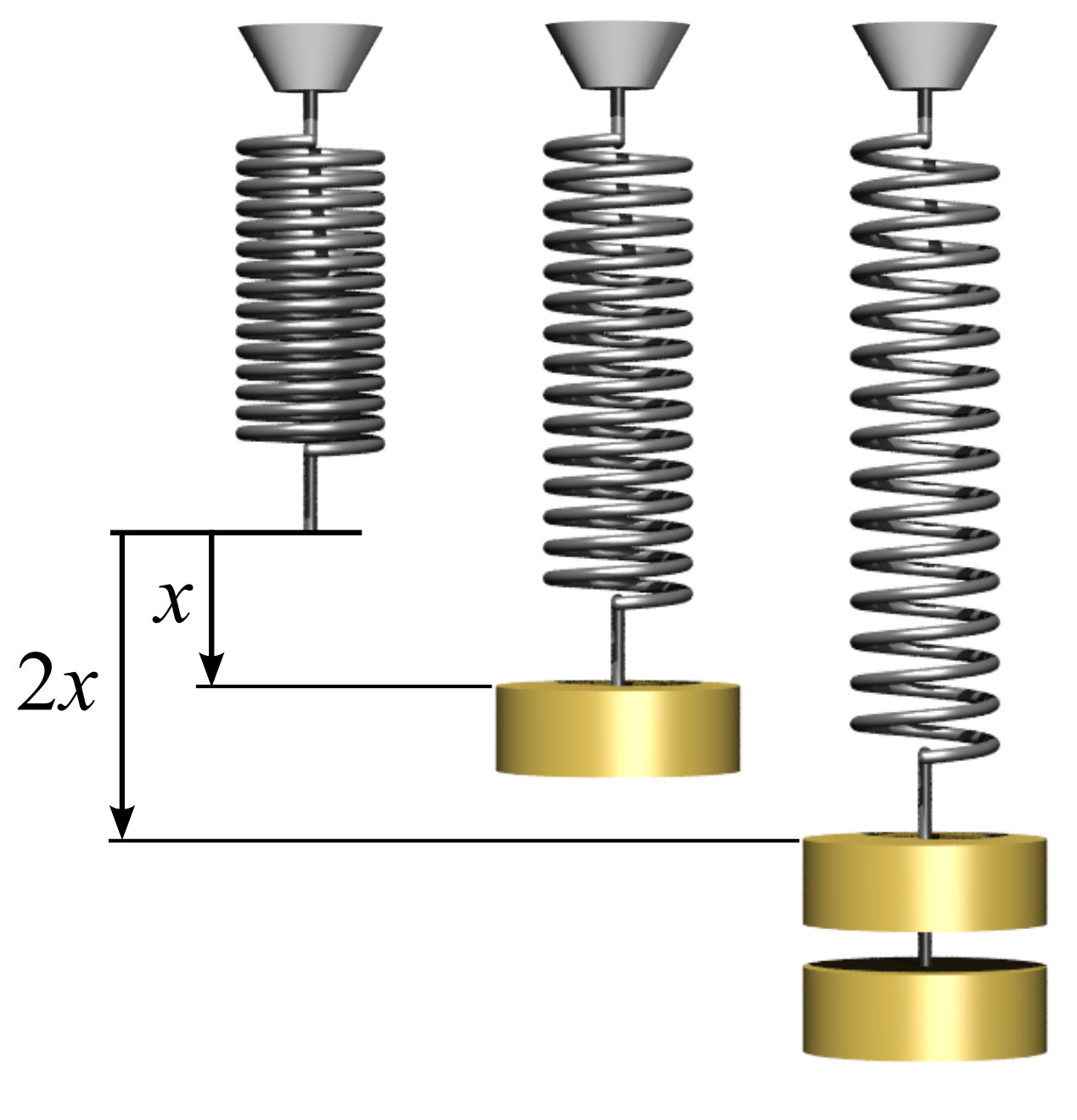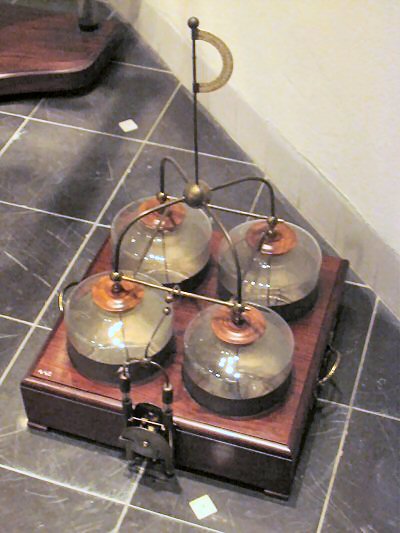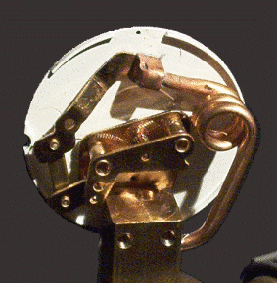|
Series And Parallel Springs
In mechanics, two or more spring (device), springs are said to be in series when they are connected end-to-end or point to point, and they are said to be in parallel when they are connected side-by-side; in both cases, so as to act as a single spring: More generally, two or more springs are ''in series'' when any external stress (physics), stress applied to the ensemble gets applied to each spring without change of magnitude, and the amount of strain (deformation) of the ensemble is the sum of the strains of the individual springs. Conversely, they are said to be ''in parallel'' if the strain of the ensemble is their common strain, and the stress of the ensemble is the sum of their stresses. Any combination of Hookean (linear-response) springs in series or parallel behaves like a single Hookean spring. The formulas for combining their physical attributes are analogous to those that apply to capacitors connected in series and parallel circuits, series or parallel in an electri ... [...More Info...] [...Related Items...] OR: [Wikipedia] [Google] [Baidu] |
Mechanics
Mechanics () is the area of physics concerned with the relationships between force, matter, and motion among Physical object, physical objects. Forces applied to objects may result in Displacement (vector), displacements, which are changes of an object's position relative to its environment. Theoretical expositions of this branch of physics has its origins in Ancient Greece, for instance, in the writings of Aristotle and Archimedes (see History of classical mechanics and Timeline of classical mechanics). During the early modern period, scientists such as Galileo Galilei, Johannes Kepler, Christiaan Huygens, and Isaac Newton laid the foundation for what is now known as classical mechanics. As a branch of classical physics, mechanics deals with bodies that are either at rest or are moving with velocities significantly less than the speed of light. It can also be defined as the physical science that deals with the motion of and forces on bodies not in the quantum realm. History ... [...More Info...] [...Related Items...] OR: [Wikipedia] [Google] [Baidu] |
Spring (device)
A spring is a device consisting of an Elasticity (physics), elastic but largely rigid material (typically metal) bent or molded into a form (especially a coil) that can return into shape after being compressed or extended. Springs can Energy storage, store energy when compressed. In everyday use, the term most often refers to coil springs, but there are many different spring designs. Modern springs are typically manufactured from spring steel. An example of a non-metallic spring is the Bow (weapon), bow, made traditionally of flexible Taxus baccata, yew wood, which when Bow draw, drawn stores energy to propel an arrow. When a conventional spring, without stiffness variability features, is compressed or stretched from its resting position, it exerts an opposing force approximately proportional to its change in length (this approximation breaks down for larger deflections). The ''rate'' or ''spring constant'' of a spring is the change in the force it exerts, divided by the cha ... [...More Info...] [...Related Items...] OR: [Wikipedia] [Google] [Baidu] |
Stress (physics)
In continuum mechanics, stress is a physical quantity that describes Force, forces present during Deformation (physics), deformation. For example, an object being pulled apart, such as a stretched elastic band, is subject to Tension (physics), ''tensile'' stress and may undergo Elongation (materials science), elongation. An object being pushed together, such as a crumpled sponge, is subject to Compression (physics), ''compressive'' stress and may undergo shortening. The greater the force and the smaller the cross-sectional area of the body on which it acts, the greater the stress. Stress has Dimension (physics), dimension of force per area, with SI Units, SI units of newtons per square meter (N/m2) or Pascal (unit), pascal (Pa). Stress expresses the internal forces that neighbouring particles of a continuous material exert on each other, while Strain (mechanics), ''strain'' is the measure of the relative deformation (mechanics), deformation of the material. For example, when a ... [...More Info...] [...Related Items...] OR: [Wikipedia] [Google] [Baidu] |
Hookean
In physics, Hooke's law is an empirical law which states that the force () needed to extend or compress a spring by some distance () scales linearly with respect to that distance—that is, where is a constant factor characteristic of the spring (i.e., its stiffness), and is small compared to the total possible deformation of the spring. The law is named after 17th-century British physicist Robert Hooke. He first stated the law in 1676 as a Latin anagram. He published the solution of his anagram in 1678 as: ("as the extension, so the force" or "the extension is proportional to the force"). Hooke states in the 1678 work that he was aware of the law since 1660. Hooke's equation holds (to some extent) in many other situations where an elastic body is deformed, such as wind blowing on a tall building, and a musician plucking a string of a guitar. An elastic body or material for which this equation can be assumed is said to be linear-elastic or Hookean. Hooke's law is onl ... [...More Info...] [...Related Items...] OR: [Wikipedia] [Google] [Baidu] |
Capacitor
In electrical engineering, a capacitor is a device that stores electrical energy by accumulating electric charges on two closely spaced surfaces that are insulated from each other. The capacitor was originally known as the condenser, a term still encountered in a few compound names, such as the '' condenser microphone''. It is a passive electronic component with two terminals. The utility of a capacitor depends on its capacitance. While some capacitance exists between any two electrical conductors in proximity in a circuit, a capacitor is a component designed specifically to add capacitance to some part of the circuit. The physical form and construction of practical capacitors vary widely and many types of capacitor are in common use. Most capacitors contain at least two electrical conductors, often in the form of metallic plates or surfaces separated by a dielectric medium. A conductor may be a foil, thin film, sintered bead of metal, or an electrolyte. The nonconductin ... [...More Info...] [...Related Items...] OR: [Wikipedia] [Google] [Baidu] |
Series And Parallel Circuits
Two-terminal components and electrical networks can be connected in series or parallel. The resulting electrical network will have two terminals, and itself can participate in a series or parallel topology. Whether a two-terminal "object" is an electrical component (e.g. a resistor) or an electrical network (e.g. resistors in series) is a matter of perspective. This article will use "component" to refer to a two-terminal "object" that participates in the series/parallel networks. Components connected in series are connected along a single "electrical path", and each component has the same electric current through it, equal to the current through the network. The voltage across the network is equal to the sum of the voltages across each component. Components connected in parallel are connected along multiple paths, and each component has the same voltage across it, equal to the voltage across the network. The current through the network is equal to the sum of the currents thr ... [...More Info...] [...Related Items...] OR: [Wikipedia] [Google] [Baidu] |
Electrical Circuit
An electrical network is an interconnection of electrical components (e.g., battery (electricity), batteries, resistors, inductors, capacitors, switches, transistors) or a model of such an interconnection, consisting of electrical elements (e.g., voltage sources, current sources, Electrical resistance and conductance, resistances, inductances, capacitances). An electrical circuit is a network consisting of a closed loop, giving a return path for the current. Thus all circuits are networks, but not all networks are circuits (although networks without a closed loop are often referred to as "open circuits"). A resistive network is a network containing only resistors and ideal current and voltage sources. Network analysis (electrical circuits), Analysis of resistive networks is less complicated than analysis of networks containing capacitors and inductors. If the sources are constant (Direct current, DC) sources, the result is a DC network. The effective resistance and current dist ... [...More Info...] [...Related Items...] OR: [Wikipedia] [Google] [Baidu] |
Hooke's Law
In physics, Hooke's law is an empirical law which states that the force () needed to extend or compress a spring by some distance () scales linearly with respect to that distance—that is, where is a constant factor characteristic of the spring (i.e., its stiffness), and is small compared to the total possible deformation of the spring. The law is named after 17th-century British physicist Robert Hooke. He first stated the law in 1676 as a Latin anagram. He published the solution of his anagram in 1678 as: ("as the extension, so the force" or "the extension is proportional to the force"). Hooke states in the 1678 work that he was aware of the law since 1660. Hooke's equation holds (to some extent) in many other situations where an elastic body is deformed, such as wind blowing on a tall building, and a musician plucking a string of a guitar. An elastic body or material for which this equation can be assumed is said to be linear-elastic or Hookean. Hooke's law is ... [...More Info...] [...Related Items...] OR: [Wikipedia] [Google] [Baidu] |
Stiffness
Stiffness is the extent to which an object resists deformation in response to an applied force. The complementary concept is flexibility or pliability: the more flexible an object is, the less stiff it is. Calculations The stiffness, k, of a body is a measure of the resistance offered by an elastic body to deformation. For an elastic body with a single degree of freedom (DOF) (for example, stretching or compression of a rod), the stiffness is defined as k = \frac where, * F is the force on the body * \delta is the displacement produced by the force along the same degree of freedom (for instance, the change in length of a stretched spring) Stiffness is usually defined under quasi-static conditions, but sometimes under dynamic loading. In the International System of Units, stiffness is typically measured in newtons per meter (N/m). In Imperial units, stiffness is typically measured in pounds (lbs) per inch. Generally speaking, deflections (or motions) of an infinitesima ... [...More Info...] [...Related Items...] OR: [Wikipedia] [Google] [Baidu] |
Truss
A truss is an assembly of ''members'' such as Beam (structure), beams, connected by ''nodes'', that creates a rigid structure. In engineering, a truss is a structure that "consists of two-force members only, where the members are organized so that the assemblage as a whole behaves as a single object". A ''two-force member'' is a structural component where force is applied to only two points. Although this rigorous definition allows the members to have any shape connected in any stable configuration, architectural trusses typically comprise five or more triangular units constructed with straight members whose ends are connected at joints referred to as ''Vertex (geometry), nodes''. In this typical context, external forces and reactions to those forces are considered to act only at the nodes and result in forces in the members that are either tension (physics), tensile or compression (physics), compressive. For straight members, moments (torques) are explicitly excluded because ... [...More Info...] [...Related Items...] OR: [Wikipedia] [Google] [Baidu] |






